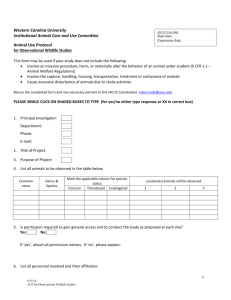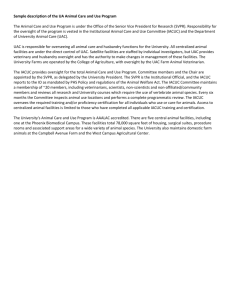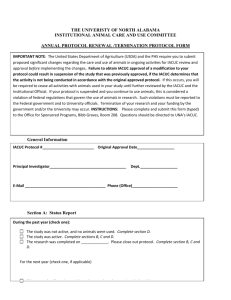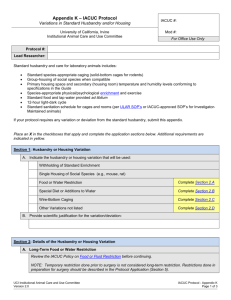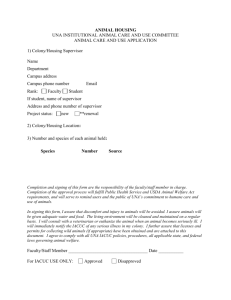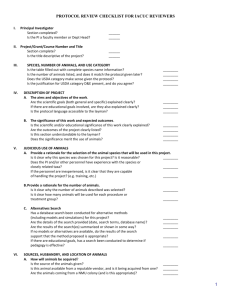Husbandry Form for Sustaining a Colony of Vertebrate Animals
advertisement
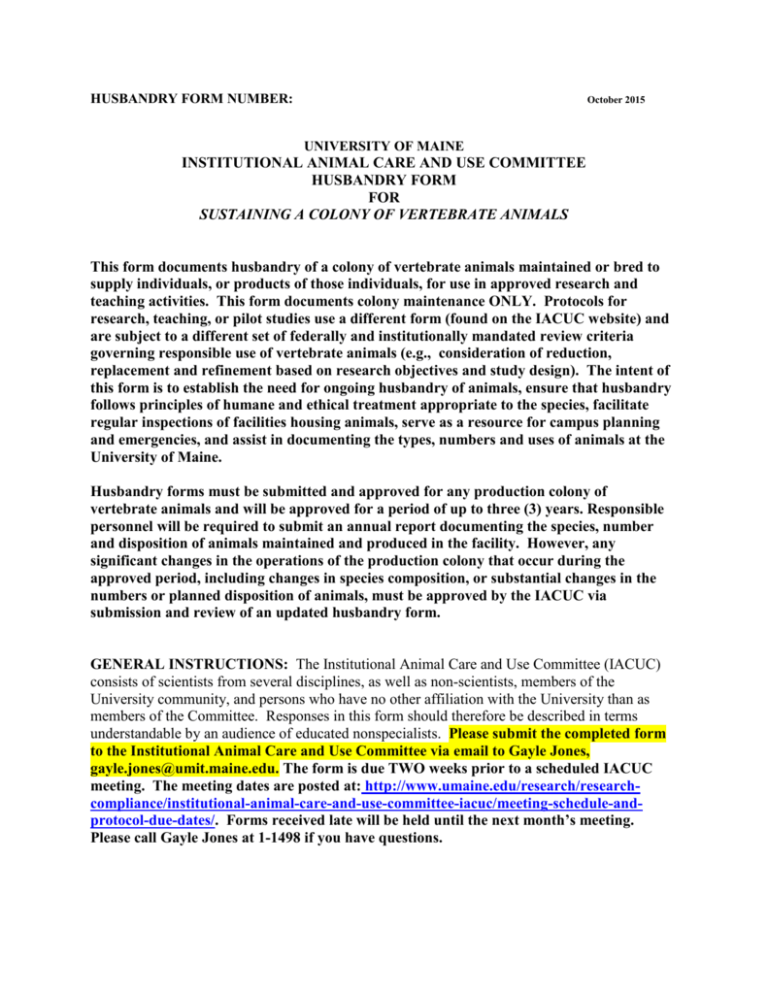
HUSBANDRY FORM NUMBER: October 2015 UNIVERSITY OF MAINE INSTITUTIONAL ANIMAL CARE AND USE COMMITTEE HUSBANDRY FORM FOR SUSTAINING A COLONY OF VERTEBRATE ANIMALS This form documents husbandry of a colony of vertebrate animals maintained or bred to supply individuals, or products of those individuals, for use in approved research and teaching activities. This form documents colony maintenance ONLY. Protocols for research, teaching, or pilot studies use a different form (found on the IACUC website) and are subject to a different set of federally and institutionally mandated review criteria governing responsible use of vertebrate animals (e.g., consideration of reduction, replacement and refinement based on research objectives and study design). The intent of this form is to establish the need for ongoing husbandry of animals, ensure that husbandry follows principles of humane and ethical treatment appropriate to the species, facilitate regular inspections of facilities housing animals, serve as a resource for campus planning and emergencies, and assist in documenting the types, numbers and uses of animals at the University of Maine. Husbandry forms must be submitted and approved for any production colony of vertebrate animals and will be approved for a period of up to three (3) years. Responsible personnel will be required to submit an annual report documenting the species, number and disposition of animals maintained and produced in the facility. However, any significant changes in the operations of the production colony that occur during the approved period, including changes in species composition, or substantial changes in the numbers or planned disposition of animals, must be approved by the IACUC via submission and review of an updated husbandry form. GENERAL INSTRUCTIONS: The Institutional Animal Care and Use Committee (IACUC) consists of scientists from several disciplines, as well as non-scientists, members of the University community, and persons who have no other affiliation with the University than as members of the Committee. Responses in this form should therefore be described in terms understandable by an audience of educated nonspecialists. Please submit the completed form to the Institutional Animal Care and Use Committee via email to Gayle Jones, gayle.jones@umit.maine.edu. The form is due TWO weeks prior to a scheduled IACUC meeting. The meeting dates are posted at: http://www.umaine.edu/research/researchcompliance/institutional-animal-care-and-use-committee-iacuc/meeting-schedule-andprotocol-due-dates/. Forms received late will be held until the next month’s meeting. Please call Gayle Jones at 1-1498 if you have questions. 2 1. Person responsible for this colony (NOTE: must be a faculty member or professional staff): Name: Campus Address: Phone: Email: Add above information for additional staff (if applicable) 2. Descriptive name of the breeding/production colony: 3. Date husbandry procedures will go into effect: (REMINDER: Activities may not begin until IACUC approval.) 4. Identify the animals (common name, genus, species) to be used, including any specific strain(s) or genotypes being maintained if applicable. 5. Provide a justification for establishing and maintaining a breeding/production colony in terms of the research or teaching operations it is intended to support. Include a statement of why it is necessary or preferable to maintain this colony on campus than to obtain animals on a need basis from other sources. 6. Animal Numbers: Estimate the number of animals that are likely to be maintained AND produced in this production facility (for each strain/line being maintained) in a given year. Explain how that estimate was obtained. Be sure to include a statement indicating why this number would likely be sufficient, but not overly excessive, to meet the probable demand for animals used in research, teaching or pilot studies. Indicate if plans are in place to reduce production when demand declines, and if that is not possible explain why. 3 7. Husbandry Procedures: List and describe husbandry procedures to be performed. Procedures that are considered largely routine for the type of animals under consideration may only require a brief description, whereas procedures that are more unique and specialized to your particular species or colony should be described in more detail. a. Procedures for breeding and rearing of offspring: b. Procedures for feeding and dietary management: c. Marking or Identification Procedures (including genotyping): d. Procedures to Manage/Maintain Densities: e. Describe the housing (cage/tank size, maximum animals per cage/tank, etc.) and indicate the maximum number of individuals you plan to house in each cage/tank: f. Describe normal cleaning procedures (frequency/indicators of need): g. Other Procedures (e.g., vaccinations, water treatments, training for the purposes of handling, specialized feeds, specialized environmental exposure): 8. Pain or Distress Classification (see Appendix 1 for classification definitions and examples). Routine husbandry procedures typically fall under USDA pain categories B and C. Procedures that fall under USDA categories D and E are more often associated with specific research or teaching protocols. If any of the above husbandry procedures require a higher pain classification than C (i.e., D or E) you will be required to consult with the institutional veterinarian, and conduct a documented search for alternatives. MUST ANSWER: Do any of the above husbandry procedures exceed USDA pain category C? (check one) No Yes - identify the specific procedure and indicate the number and type of individuals to which it would be applied and complete the following. 4 a) Veterinary Consult: This must occur before the husbandry form is considered for review. Please email Dr. James Weber, jaweber@maine.edu, with a description of the proposed procedures. Date of veterinary consult: b) 9. Search for Alternatives: This must occur before the husbandry form is considered for review. A written narrative documenting that less painful alternatives are not available must be included -- following the USDA Policy and using the form available at the end of this document. Animal Sourcing and Housing: a. b. Sourcing: 1. What is the original or supplemental source of animals for this colony (vendor, field collection, other institutions). 2. If animals are field collected, what procedures will be used to capture and transport them in a way that reduces risks of injury or death? 3. Have you obtained necessary permits required to import, hold or collect these animals? 4. What procedures will be used to reduce the potential for pathogens to enter this facility and be transmitted to other animals or humans (e.g., quarantine, prophylactic treatments, vendor health certificates, vaccination, treatment of air, water or waste streams). Housing: IMPORTANT NOTE: Personnel are expected to follow care and housing guidelines outlined in the Guide for the Care and Use of Lab Animals (http://grants.nih.gov/grants/olaw/Guide-for-the-Care-and-Use-of-LaboratoryAnimals.pdf) or the Guide for the Care and Use of Agricultural Animals in Agricultural Research and Teaching (http://www.fass.org/docs/agguide3rd/Ag_Guide_3rd_ed.pdf) unless special exceptions are requested and approved. If specific requirements for your animals are not listed in the Guides (e.g. some wildlife), you are expected to adhere to recommended practices of the field (e.g., as outlined by professional societies) 5 and known biological needs of the species. All personnel working with housed animals are expected to keep records of daily care/feeding, as well as records of other periodic care (e.g., grooming, water quality) for inspection by the IACUC. 1. Where will the animals be housed and maintained for this colony (building, room, etc.)? 3. Does your housing deviate from the requirements of the Guides or recommended practices? Yes/No. If yes, include a justification for an exception to the Guides for taxa covered therein. For taxa not covered by the guides, specify any other guidelines you intend to follow 10. Describe the method(s) of euthanasia that will be used to manage the density of animals, provide humane end of life for animals retired from production, or to relieve pain and suffering in animals that experience unanticipated illness or injury.* *See the 2013 Report of the AVMA Panel on Euthanasia for assistance (https://www.avma.org/KB/Policies/Documents/euthanasia.pdf). NOTE: When possible, euthanasia should be conducted in a place or fashion that minimizes the potential for cues that could cause distress in other animals (e.g., outside housing room or in an isolated chamber or container). 11. List all person(s) who will handle animals (e.g., carry out the procedure(s), animal care, etc.) or provide training of personnel. For each person named below, describe his/her individual experience in performing proposed procedures (e.g., years of experience and specific skills); if none, explain how training will be obtained. (NOTE: to add rows, right-click within table, click on “insert” and choose “insert rows above” or “insert rows below”) Personnel Name Role Years of experience Training plan (if no experience) 6 12. Have all personnel named above been certified by the IACUC for Responsible Care and Use of Animals? Yes No A web-based tutorial for this certification is available at: http://umaine.edu/research/research-compliance/institutional-animal-care-and-usecommittee-iacuc/web-based-training/. (Note: approval will not be granted until all personnel have been certified.) 13. Please list the name, phone number, and email of the person who should be contacted to accompany the IACUC during facility inspections: 14. Disaster Planning and Emergency Preparedness. The Guide requires that facilities have disaster plans to “define the actions necessary to prevent animal pain, distress, and deaths due to loss of systems such as those that control ventilation, cooling, heating, or provision of potable water.” Safety and Environmental Management, in conjunction with the IACUC and researchers, are putting disaster plans in place that meet University and individual investigator needs, include provisions for triage and euthanasia, and provide for training and contact of essential personnel. Please provide the following information: a. Triage: Some animals may require priority care (or euthanasia) under a facilitywide or campus-wide disaster. For example, they may have greater potential to experience severe pain or distress under disruption of services (e.g., postoperative individuals) or they may be irreplaceable in a replicate study (e.g., novel genetic lines). Do any animals used in this colony require special priority for triage? If so, please describe the basis for this special priority and indicate how such animals will be made identifiable within the facility (e.g., special marks, lists). b. Special Euthanasia: Would a different method of euthanasia than that listed in section 11.d. be used in the event of a disaster that disrupts normal services required for humane care and treatment of these animals? If yes, please describe the special method (include dosing information for pharmaceutical approaches). c) If the facility is not a “core” facility (Aquaculture Research Center, Center for Cooperative Aquaculture Research, Small Animal Research Facility, or the Witter Center), you will need to have on file with the IACUC a Satellite Facility Designation and Disaster Plan (contact the IACUC Office for the form). 7 I currently have a Satellite Facility Designation and Disaster Plan for my lab on file with the IACUC. I have attached a completed Satellite Facility Designation and Disaster Plan for approval. d) Emergency Contacts for Care of Animals (at least two people must be listed): Primary person to contact in case of an emergency = Office phone = Home phone = Cell phone = Secondary person to contact = Office phone = Home phone = Cell phone = Tertiary person to contact = Office phone = Home phone = Cell phone = 8 Risk Assessment (Risks to researchers) In compliance with our Public Health Service Animal Welfare Assurance, we have implemented an Occupational Health/Medical Surveillance Program. The first step is for responsible personnel to identify potential hazards associated with animal care and use, so the IACUC veterinarian and Safety and Environmental Management (SEM) can assess the risks to determine if further information will be required from everyone named in the form (i.e., a health questionnaire). NOTE: In evaluating this risk assessment statement, we will be looking for animal care tasks that increase the risk of illness (such as a zoonotic disease), physical injury (such as animal bites, sharp instrument), and/or allergic reactions to those handling the animals. Also consider hazards of animal excrement/hazards to workers handling the animals’ bedding that may be important to an accurate risk assessment. Please complete the following for your proposed husbandry form. a) Provide a brief description of the colony to be established. b) List the tasks required. 1. 2. 3. etc. c) For each of the tasks described in b) above, list the associated hazards. 1. 2. 3. etc. d) For each of the hazards described in c) above list how the hazards will be managed. 1. 2. 3. etc. 9 After this risk assessment is reviewed, everyone named in the form may be required to complete a health questionnaire. The health questionnaire may require review by the Occupational Health Physician. If so, there is a charge for this review (~$45). Researchers are asked to budget for these costs in proposals for outside funding. For unfunded studies, the cost will be covered by the Office of the Vice President for Research. If you have any questions regarding the completion of this page, please contact, Safety and Environmental Management (SEM), 1-4055. Reviewed by SEM: ____________________________________ _________________ Signature Date 10 SEARCH FOR ALTERNATIVES TO PAINFUL/DISTRESSFUL PROCEDURES This form must be completed if the pain classification from Question #8 was D or E Please read the background information on the USDA policy for painful and distressful procedures before completing this form (Appendix 1) The written narrative should include adequate information for the IACUC to assess that a reasonable and good faith effort was made to determine the availability of alternatives or alternative methods. The following information is required: 1) The names(s) of the database(s) searched (due to the variation in subject coverage and sources used, one database is seldom adequate); 2) The date the search was performed. 3) The time period covered by the search. 4) The search strategy (including scientifically relevant terminology) used. 5) Did your database search (or other source) identify a bona fide alternative method (one that could be used to accomplish the goals of the animal use proposed? Yes/No. If yes, please explain why the alternative found was not proposed. (NOTE: The IACUC can withhold approval of the study if it is not satisfied with the procedures proposed for use in the study.) 11 ASSURANCES FOR THE HUMANE CARE AND USE OF ANIMALS As the staff person responsible for this animal colony, I assure that… 1) I have provided an accurate description of the animal care and use procedures to be followed in maintaining this colony. 3) all individuals who become involved with maintenance of this colony and who are at risk, will be registered in the Occupational Health and Safety Program. 4) all individuals performing animal procedures described in this application are technically competent and have been (or will be) properly trained in the procedures to ensure that no unnecessary pain or distress will be caused as a result of the procedures. 5) I will obtain approval from the IACUC before initiating any significant changes or additions to the procedures herein. 6) I am familiar with and will comply with the University of Maine’s Policies and Procedures for the Humane Care and Use of Animals, and I assume responsibility for compliance by all personnel involved with this colony. 7) I have read and will follow the appropriate guidelines for the proposed species. 8) if using laboratory animals, all personnel handling the animals have had a tetanus shot within the past ten years. 9) all applicable rules and regulations regarding radiation protection, biosafety, recombinant issues, hazardous chemicals, etc., have been considered in the preparation of this application and the appropriate reviews/consultations have been initiated. 10) animals will be purchased only from licensed, reputable vendors. 11) I will maintain appropriate animal records (e.g., census, health, veterinary care, euthanasia, surgery, diagnostic, anesthesia, etc.) 12) I will report at once to the IACUC any unanticipated harm to animals. 13) I acknowledge that in the event of a disaster (natural or man-made) it may become necessary to triage, euthanize or otherwise modify the care and disposition of the animals described herein in order to avoid unacceptable pain or distress. I delegate overriding authority for emergency decisions of animal disposition to the Institutional Veterinarian or his/her designated representative. Submitting the completed husbandry form indicates you have read and agree to the above Assurances. 12 HUSBANDRY FORM NUMBER: Title: Name of Responsible Person: --------------------------------------------------------------------For Committee Use Only: Date of IACUC Receipt: ___________ Committee Action: _____ 1. _____ 2. _____ 3. _____ 4. Approved until ___________________ Species and # of animals approved: _________________________________ Modifications required. Modifications accepted for approval: _______________ Approved until: ____________ Species and # of animals approved: _________________________________ ______________________________________________________________ Disapproved. See attached statement. Reviewed and determined not to fall under the Policies and Procedures for the Humane Care and Use of Animals (explanation) ________________________ _______________________________________________________________ Full IACUC Review: _______ Date Designated Member Review: _______ date Member: _________________________ IACUC Signatures: _______________________ _______________________ ______________________ _______________________ _______________________ ______________________ _______________________ _______________________ ______________________ October 2015



